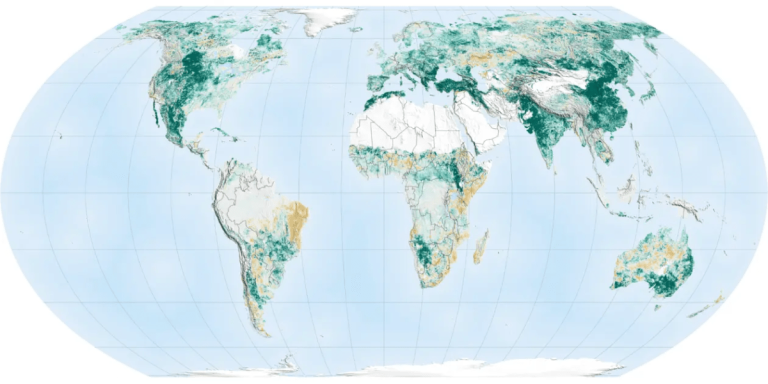Originally published in Climaterealism

Figure: From 2000 to 2017, foliage in green areas increased, while foliage in brown areas declined. Joshua Stevens/NASA Earth Observatory
An article published by Yale Environment 360 on July 16 claimed that global greening is not a positive but a negative because it harms water supplies. This statement is amusing at best and misleading at worst. The authors acknowledge that many scientists view the greening of the planet as a result of increased carbon dioxide emissions, especially in desert areas, as beneficial, but attempt to frame this as a negative effect.
The Yale Environment 360 article titled “The world's drylands are turning green as carbon dioxide levels rise” is interesting because its author, Fred Pearce, can't help but put a negative spin on some very positive news.
The subtitle of the article reads:
Despite warnings that climate change will cause widespread desertification, many drylands are becoming greener due to rising levels of carbon dioxide in the air — a trend that recent research suggests will continue. But scientists warn that increased vegetation could drain scarce water resources.
First, we should commend Yale Environment 360 for bringing good news about the impact of carbon dioxide (CO2) on a green planet. Article supplement:
what is going on? Recent studies have concluded that the main reason is that the concentration of carbon dioxide in the atmosphere has increased by 50% since pre-industrial times. Increased carbon dioxide not only contributes to climate change but also accelerates photosynthesis in plants. By allowing them to use scarce water more efficiently, carbon dioxide-rich air can encourage vegetation growth in even some of the driest places.
Greening due to increased carbon dioxide is something we have previously reported on climate realism. Satellite measurement data shows that in the first 20 years of the 21st century, the global green area increased by about 5%Yingshi century. The Sahara Desert is getting smaller and smaller as a result. A 2018 study by Venter and others found that the Sahara desert has shrunk by 8% in the past three decades.
Pierce's claims are controversial, “but scientists warn that increased vegetation could drain scarce water resources.”
This is simply untrue. For example, in Africa, trees made desert lands fertile again:
This time, there is some good news coming from Africa. Farmers are reclaiming the desert, turning the barren wasteland of the Sahel region on the southern edge of the Sahara into green, productive farmland.
Satellite images taken this year and 20 years ago show the desert is receding due to the resurgence of trees. They are mainly Anna trees (white grass), a type of acacia tree. Wherever there are trees, farming can be resumed.
Tree-planting activities have regreened up to 3 million hectares of land in Niger, allowing about 250,000 hectares to be cultivated again.
The key factor is evapotranspiration. Evapotranspiration, the combination of evaporation and plant transpiration (water passing from leaves into the air), is a key factor in desert formation. Deserts form when more water evaporates from the ground than rain or snow falls. This is because the desert is arid, with no more than 10 inches of precipitation per year.
Evapotranspiration is an energy-driven process that increases with temperature, solar radiation, and wind. In deserts, rapid heating and cooling of air creates strong winds that circulate hot, dry air, further increasing evaporation rates. For example, in American deserts, evaporation can range from 70 to 160 inches per year. At this rate of water loss, deserts remain deserts—they're locked in by the evaporation process.
But for trees, this cycle is broken. Leaves both reflect and absorb sunlight, thereby reducing solar radiation to the ground and thus lowering ground temperatures. Since ground temperatures are cooler, canopy shade actually reduces evaporation and therefore helps the desert retain more groundwater.
Moderate warming has led to a slight increase in rainfall totals. Additionally, as Agriculture and Botany explains, under conditions with higher carbon dioxide levels, plants use water more efficiently and lose less water through transpiration. As a result, plants use water more efficiently, and the increase in plants reduces water loss in dry areas. How terrible!
This is basic plant science and has been known for decades to reduce any purported increase in water use, but Pierce completely ignores this. Or maybe he knows this and prefers to continue telling the narrative that CO2-driven climate change is the cause of everything bad that happens on Earth, regardless of the facts.
For the many examples we illustrate each week, see climate realism With the media insisting on this narrative in the face of contrary facts, it’s no surprise that Yale Environment 360 is trying to turn the good news about global greening into bad news. Shameful, but not surprising. For climate alarmists, maintaining the narrative seems more important than reporting the facts.

Anthony Watts
Anthony Watts is a senior fellow in environment and climate at the Heartland Institute. Watts has been in the weather business both in front of and behind the scenes since 1978 as a live television meteorologist and currently oversees daily broadcast forecasts. He created television weather graphics presentation systems, professional weather instruments, and co-authored peer-reviewed papers on climate issues. He runs the world's most viewed climate website, the award-winning wattsupwiththat.com.
related
